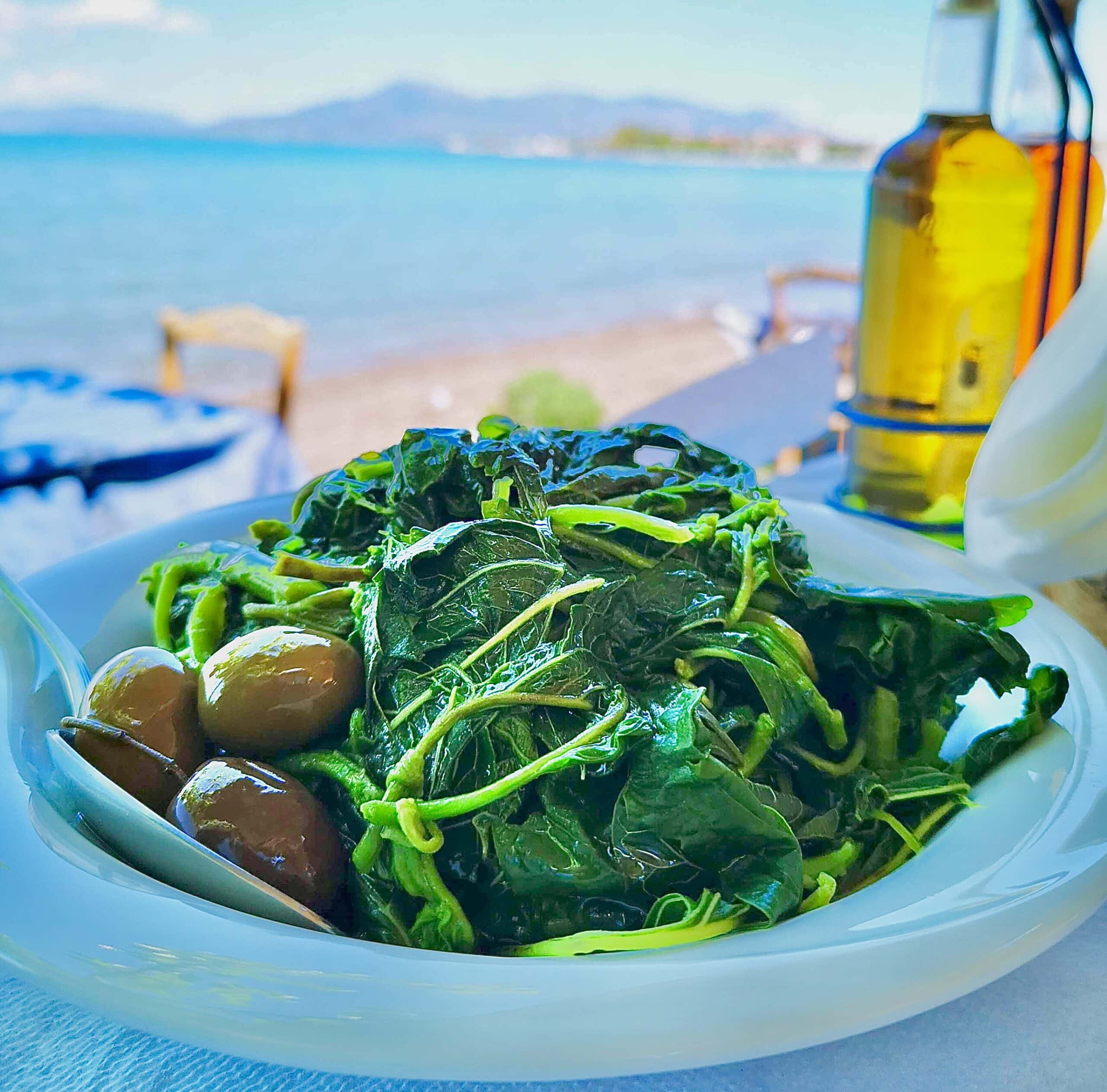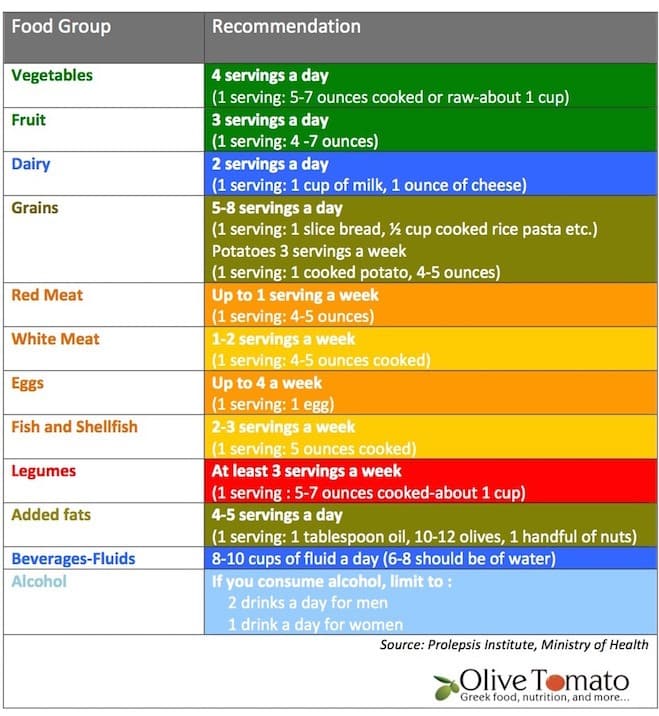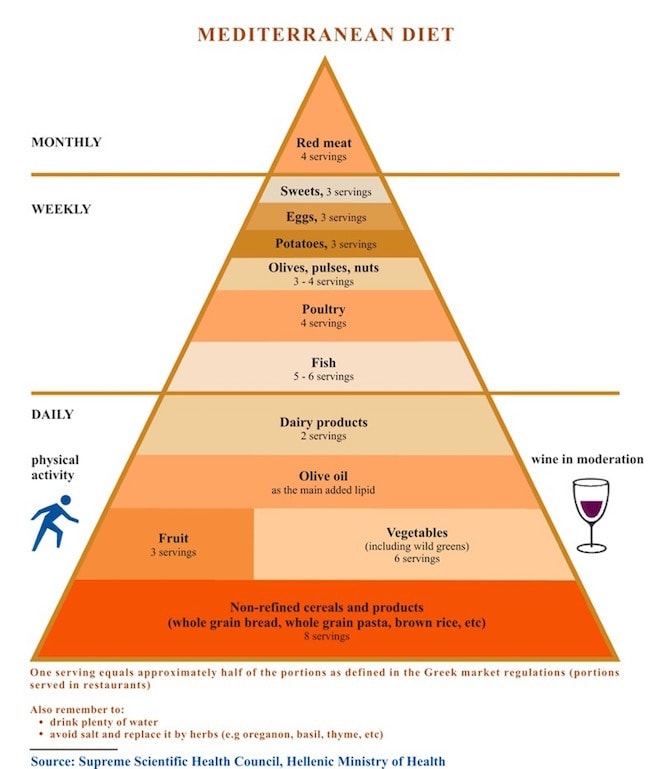The Authentic Mediterranean Diet Guidelines

As you may know, the Mediterranean Diet was based on the eating habits of the people, living on the Greek island of Crete in the 1950’s and 60’s. These people had virtually no heart disease and had the highest life expectancy in the world at that time. Researchers recorded their eating habits and eventually came up with the Mediterranean Diet Pyramid. In their paper published in the American Journal of Clinical Nutrition, physicians and nutrition researchers describe the Mediterranean diet as a diet based on food patterns typical of Crete, much of the rest of Greece, and southern Italy in the early 1960s, where adult life expectancy was among the highest in the world. These very same guidelines are also the official dietary guidelines of Greece.
If you are tired and confused with all those vague descriptions of a pseudo Mediterranean diet and want the real thing, you are at the right place! Scroll down to find just how many servings you need every day of each food group.
Authentic Mediterranean Diet Guidelines

*Table above has been developed and translated by Elena Paravantes. Unauthorized use of this table is prohibited.
And here is the original Greek Diet pyramid, which is essentially a Mediterranean diet:

Want More Mediterranean Diet Guidance? Get my top-rated book!
Get it here >> The Mediterranean Diet Cookbook for Beginners


Elena I love your blog. You have taken me back to my roots
Thank you
Thank you Irene!
What would be a serving of softer cheeses like feta please? I think they are lower in calories than hard cheese?
Also, do things like dates and dried figs and also avocado, count?
Thank you!
Thank you Elena, this is really great. I was just wondering, who are the guidelines for? Do you recommend to vary them by age or activity level (I am 28 year old girl, and I walk every day)?
Hi Kristina, The guidelines are for adults with average activity.They do have specific recommendations for children as well.
Got it – thanks 🙂 Cups definitely make a *lot* more sense – I only noticed on the Prolepsis website they don’t mention them. But if you say so, I’ll take it 🙂
Thanks Elena 🙂 xx
Yes, generally Greek Guidelines do not use cups, but I “translated” into cups as well.
Thank you so much Elena for this super-informative article – exactly what I’ve been looking for. I’m a bit confused though by the vegetable serving sizes…Today I made a scaled-down version of your (delicious!) fasolakia lathera, the beans, tomato and onion together (raw) weighed barely 300g but there was so much, I could barely finish it! Can a big plate like that really be only two of the four recommended daily servings? (Not to speak of 150g salad leaves!) Am I missing something?!
Thanks again for an awesome site, so glad I can now make my favourite Greek dishes at home 🙂
Thanks Aimee! The recommendation is 4 cups of vegetables, so it depends on the serving, it looks like you would be getting more. I do mention in the fasolakia recipe that you can easily get 4 servings of vegetables in one meal.
After suffering double breast cancer in 2014 l am focusing on my diet. The Greek diet seems to me the best and your table of the recommendations for an adult helps me lots.
Can l ask a question, when l have been reading up about diet l came across the “Ikaria” diet. I was wondering if you could post about it on your blog and maybe suggest some recipes. If that is okay with you.
The Ikaria diet is actually the Greek diet 50 years ago, in other words the prototype of the Mediterranean diet. I’ve written about it here: https://www.olivetomato.com/live-longer-with-the-greek-lifestyle-eat-plants-and-drink-wine/
I hate to ask such a silly question but, what group are beans and lentils in? Grains?
Hi Rachele,
Beans are under the category “legumes”
Elena,
Yesterday I made the traditional greek cauliflower dish on your web site. It was delicious and I was amazed at how good something that simple could taste. I had it for lunch with some feta and sourdough bread. I know that these lathera are popular during fasting, but do Greeks eat something like this daily or several times a week?
Hi Mary,
Wonderful. Yes these dishes are consumed all year round, I would say about 2-3 times a week. Although nowadays many younger Greeks eat much more meat based dishes than lathera.
I love this article. I googled “Greek diet” today because I think the new US recommendations are BS. I lived in Spain for 2 years and know that this version of the med. diet is not truly Mediterranean at all! My doctor told me to start adding whole milk to my diet and more full-fat cheese so I can eat more like a Mediterranean person–ha! In Spain I possibly had 1/4 c milk per day and a small slice of cheese. In the US, dairy is about 1/2 of our diet it seems like and bread is the other half! Of course we want to support our farmers, but we need to shift not only the portions but also the focus of what we cook from meat/grain/veg as a side to delicious stews and salads that incorporate more veggies. If only we had a better understanding how to cook vegetables in this country to make them delicious to our children. Americans are so bad at cooking veggies–but we are getting better! Thanks for the recipes!!!
Thanks for sharing your experiences Laura. Yes, making vegetables delicious is key to getting children to eat more of them.
I just discovered your web site and it is great. I’ve been interested in Greek diet habits (and especially Ikarian eating habits) since I read a couple of the Blue Zone books. It looks like there is lots of interesting information on this site. One thing I noticed from the Greek Diet Pyramid above, is that they also seem to want to follow the old US pyramid in emphasizing grains (by putting it at the base of the pyramid). If you look at the pyramid, they really should put fruits and vegetables at the base of the pyramid (9 servings compared to the 8 servings for grains).
Thanks Mary,
Yes that Greek Pyramid is from 1999, so the current guidelines are in table form (above) recommending 5-8 servings of grains a day.
I found it interesting that the Greek guidelines called for low-fat dairy, just like the US FDA guidelines … when we now know that whole milk is really more nutritious (and that eating fat doesn’t make us fat). I’m sure the Greeks following the traditional diet were drinking their goat milk whole, and their goat cheese was made from whole milk, too.
Hi Steve, Yes I agree on that point. And yes you are correct traditional Greek cheeses are full fat.
Thank you I love your posts. I visit Cyprus a couple of times a year and I enjoy the food.
Great read. Eating like a Greek should be the dietary guidelines!
Thanks Karen! I think so too.
GOOD, HEALTHY RECIPES!!!!
Many special thanks!
Mary/Texas
Thanks Mary!
You are always so informative and also bring us such great recipes . I get excited when I see an email from you because I know it will be special.
Σας ευχαριστω πολύ,
Δόμνα από Καλιφορνια
What a great compliment! Thank you Domna.